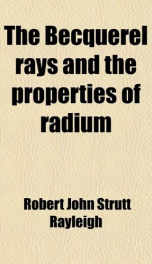the becquerel rays and the properties of radium

Purchase of this book includes free trial access to www.million-books.com where you can read more than a million books for free. This is an OCR edition with typos. Excerpt from book: CHAPTER VI RADIO-ACTIVITY IN THE EARTH AND IN THE ATMOSPHERE It was mentioned in Chapter n. that some soils contained radium. We shall now describe some of the experiments by which this has been proved to be the case. In the first place, it is found that the air in cellars or caves possesses a marked ionisation.1 This has been traced to the presence of radium in the soil; the emanation of this radium diffuses into the air of the cave or cellar from the surrounding soil, and ionises it. The same effect can be obtained still more conspicuously by sinking a pipe into the earth, say a yard down, and sucking up a sample of air from the soil. Such air possesses marked conductivity; the conducting power falls to half its initial value in a little less than four days. This shows that it is due to the radium emanation. No very complete investigation of the amount of radium in various soils has yet been made. Clay soils are usually the most active, but Professor J. J. Thomson has found the sand from the beach at Whitby to be very active too. Much more active than any ordinary soil is the deposit left by the water of certain thermal springs. The author has found strong emanating power in the deposits of Bath and Buxton. The water of thesesprings rises from great depths below the earth, and reaches the surface very hot. At Bath the temperature of the water at the spring is higher than can easily be borne. As the water cools it deposits a fine red mud in the tanks and pipes. This mud is found to give off radium emanation in abundance, though not, of course, nearly so strongly as pitchblende. The mud deposited near the spring is stronger in emanating power than what is deposited further away. 1 This ionisation is much larger than that observable in closed vessels, which will b...
Info about the book
Author:
Series:
Unknown
ASIN:
B00AYSNM6M
Rating:
4/5 (6)Your rating:
0/5
Languge:
English
Users who have this book
Users who want this book
What readers are saying
What do you think? Write your own comment on this book!
write a commentGenre
if you like the becquerel rays and the properties of radium try:
Other books by this author
Do you want to read a book that interests you? It’s EASY!
Create an account and send a request for reading to other users on the Webpage of the book!

